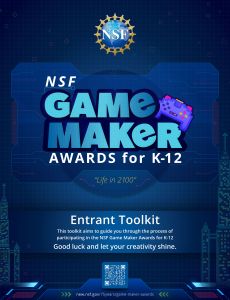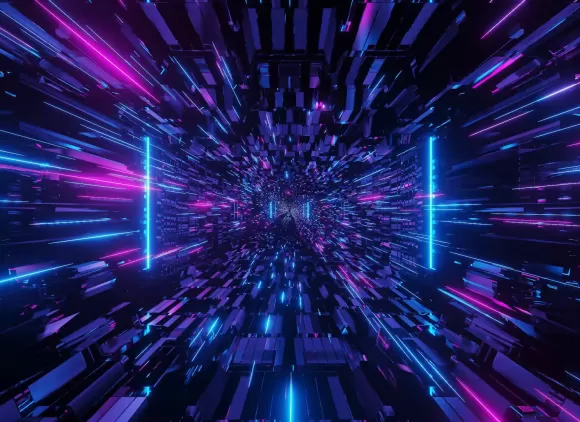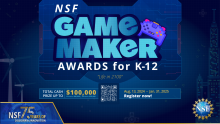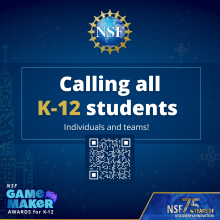Explore tools like codeSpark, Scratch, Unity and Unreal Engine to create your game. Use online tutorials and forums to enhance your skills and get inspired by other projects.

NSF Game Maker Awards Entrant Toolkit
updated with additional information
 On this page
On this page
Game development platforms
CodeSpark (Top platform for elementary school)
- Intro to Game Design in codeSpark with super teacher Kristen Brooks.
- Free access for teachers and students.
Scratch (Top platform for upper elementary and middle school)
- Online platform that combines computer programming with graphic design tools to allow users to create games, animations, and other interactive programs.
- This resource guides users through the process of using Scratch to learn the basics of programming and game design.
- Scratch game tutorials.
- Scratch Design Journal.
- Scratch Ideas & Resources.
- Starter Projects.
- Scratch YouTube Channel.
Unity (Top platform for high school - 16+)
- If you are new to game design then check out Unity Essentials and Create with Code.
- For aspiring programmers: Jr. Programmer Pathway.
- For aspiring game artists: Creative Core!
- For students under 16: Free teacher and student accounts.
- For students 16+: Free teacher and student accounts.
Unreal Engine
- The same powerful technology used by major studios. An end-to-end ecosystem to create, ship and operate games.
- Learning Library.
Snap!
- Snap! is a visual programming language for kids and adults, inspired by Scratch, but with the tools teenagers need to do serious computer science: procedures as first class data, lists as first class data, higher order functions, APL-style hyperblocks, metaprogramming, and more.
Tutorials and guides
Kodu Game Lab
- 3D game development environment designed to teach kids basic programming principles.
- Game design courses.
Minecraft Education
Gamestar Mechanic
- Uses game-based quests and courses to help students learn game design and make their video games.
- Resources for teachers.
- Resources for parents.
Game Salad
Games for Change resources
Schell Games
- "A Deck of Lenses" (use this free interactive tool to review your game design ideas and make them better!)
www.code.org (Resources for game design)
- Elementary school kids.
- Kids ages 11 and up.
- Game Design (Grade: 3+, Instructional Hours: 5, Self-Paced PL Available)
- Coding with AI (Grades: 6–12, Instructional Hours: 1 Week, Self-Paced PL Available)
Examples of Learning Games
- Field Day (supported and run by the University of Wisconsin).
- Filament Games is a full-service digital studio specializing in learning game development for hire basis.
Articles
Multimedia resources
Free, noncopyrighted image sources
Free, noncopyrighted audio sources
Multimedia Gallery
Protecting your video game and creative work
Now that you've created your video game, you might wonder: How can I protect my original creation? Below are a few simple steps and helpful resources to get you started on safeguarding your work.
- Write down your ideas: Document your game's concept, characters and code. Keep notes and versions of your work to prove it's yours.
- Register your copyright: In the U.S., you automatically have copyright protection once you create your game. However, to officially register it, you can go to the U.S. Copyright Office's website and submit an application. You'll need to describe your game and upload the files.
- Use a license: If you want others to use or modify your game, consider adding a license (like Creative Commons). You can specify what others can and can't do with your game.
- Trademark: If you have a unique name or logo for your game, you might want to consider trademarking it to protect that name or image from being used by others. Just be aware that the costs can add up quickly depending on how you file and where (state or federal level).
- Keep your code safe: Use secure storage, like GitHub or another version control system, to keep track of your game's source code and any updates.
Resources
Below, we have included helpful resources available from the United States Patent and Trademark Office (USPTO)
Outreach toolkit
Credit: Seila Sarun / Ensemble Government Services LLC.
Download a 4 x 6 postcard
Download a 5.5 x 8.5 postcard
Download a 5 x 7 postcard
Download a 6 x 9 postcard
Social media
Sample social media
The NSF Game Maker Awards for K-12 are now live! NSF is looking for students to create video games imagining life in 2100. Learn how to get involved and discover how students and mentors can win a share of the $100,000 prize pool: new.nsf.gov/75years/game-maker-awards




